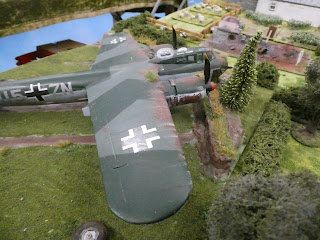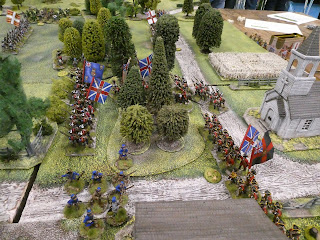 |
| An overview of the Dervish position |
Finch, knowing the aggressive nature of his commander adopted a rather energetic form of pinning; he led his cavalry straight towards the mass of Dervish cavalry, leaving Chambers and the machine gun to protect the British left. Fortune favours the brave and the leading unit of lancers was unscathed by the ineffectual rifle fire from the Dervish infantry. Adding to Emir Khat's woes one of his field guns suffered a misfire, jamming the breech and putting the gun permanently out of action. The Dervish cavalry were unsure of how to respond to the British advance, only one unit moved forward and that was quickly overwhelmed. Spurred on by this success the lancers swept on and struck another unit of Dervish cavalry. This proved rather more resilient and held its ground and the fight continued. Finch called up his second unit and as the first unit of lancers fell back the second charged into their Dervish opponents. This fresh assault was too much for them to take and they routed, carrying away their supports.
 |
| Finch's command move forward |
Emir Khat had seen the British cavalry moving towards his right wing and sent an order for the infantry there to take cover in the broken ground. Unfortunately, the messenger did not get through and the Dervish infantry in the open were driven back in total disarray. Sensing victory, the cavalry raced forward in pursuit, hacking and slashing at any unfortunate Dervish infantry they caught. Meanwhile , on the ridge, Armstrong's other unit was struggling to overcome the Dervishes opposing them in rather broken terrain. To make matters worse, another Dervish unit joined the fray; but, rather than helping, they seemed to hinder the defence and in the end, both sides fell back to reorganise.
 |
| Armstrong's Hussars attack the Dervish infantry |
Gregory's leading infantry battalion had by now reached the central ridge. The rifle fire from the Dervish infantry continued to be ineffective and proved unable to stop the British advance. The commander decided to revert to cold steel and ordered an immediate charge. This was the opportunity Gregory had hoped for. His infantry stopped and then delivered a withering close range volley which decimated the Dervish ranks. Halting, the Dervish were subjected to another volley and they fell back in disorder.
Gregory ordered the advance to continue and the 83rd (Kelhamshire) proudly took the ridge. Behind them the Highlanders felt cheated that they had been denied the chance to prove their mettle, but their time would come.
On the British right, Chambers had managed to drive off one unit of Dervishes with sustained volleys, but his other unit was being sniped at by some riflemen from an area of broken ground. Determined to eliminate this nuisance he ordered this unit to advance although this opened up a gap in his lines. Advancing rapidly the British infantry drove off their assailants, scattering them to the four winds. The major's cry of "well done the 61st !" was drowned by frantic shouts of "'ware cavalry" from the left, as a mass of horsemen broke cover. A square began to form, but was not complete before the horsemen were on them. A frantic fight ensued, with knots of soldiers fending off the lances, spears and swords with their bayonets. Against the odds, the infantry prevailed, the horsemen falling back to reform. The cost had been high, a third of the battalion lay dead or dying. A ragged line formed and with the help of the machine gun they managed to keep the enemy horsemen at bay as the survivors fell back .
 |
| The Lancers attacked in the flank |
 |
| The lancers driven off |
On the British left, Armstrong had lost all contact with his leading unit. He was fully occupied rallying the unit driven off the ridge. The Hussars, which had pursued the routing Dervish were now milling about with officers struggling to restore some semblance of order to the ranks. There were plenty of opportunities to charge disordered Dervish infantry, but a ragged fire from several directions hampered attempts to form up.
Glenister at last realised that a retreat was necessary if anything was to be salvaged from the day. He ordered Chambers to form a rearguard and Armstrong to assist Gregory. Armstrong did what he could, but Gregory's fate was sealed when the Dervish cavalry swooped down on his command. Only a fraction of the 83rd and the Highlanders managed to escape to join the artillery and Chambers. Armstrong's men managed to hold off the Dervish pursuit long enough for Glenister to make good his escape.
An enjoyable scenario. The revised factors gave the British troops a better chance of survival, as long as they had the time. Unfortunately, the Dervish troops did not give them the time. With a superior number of units they were able to wear down the British troops.



























